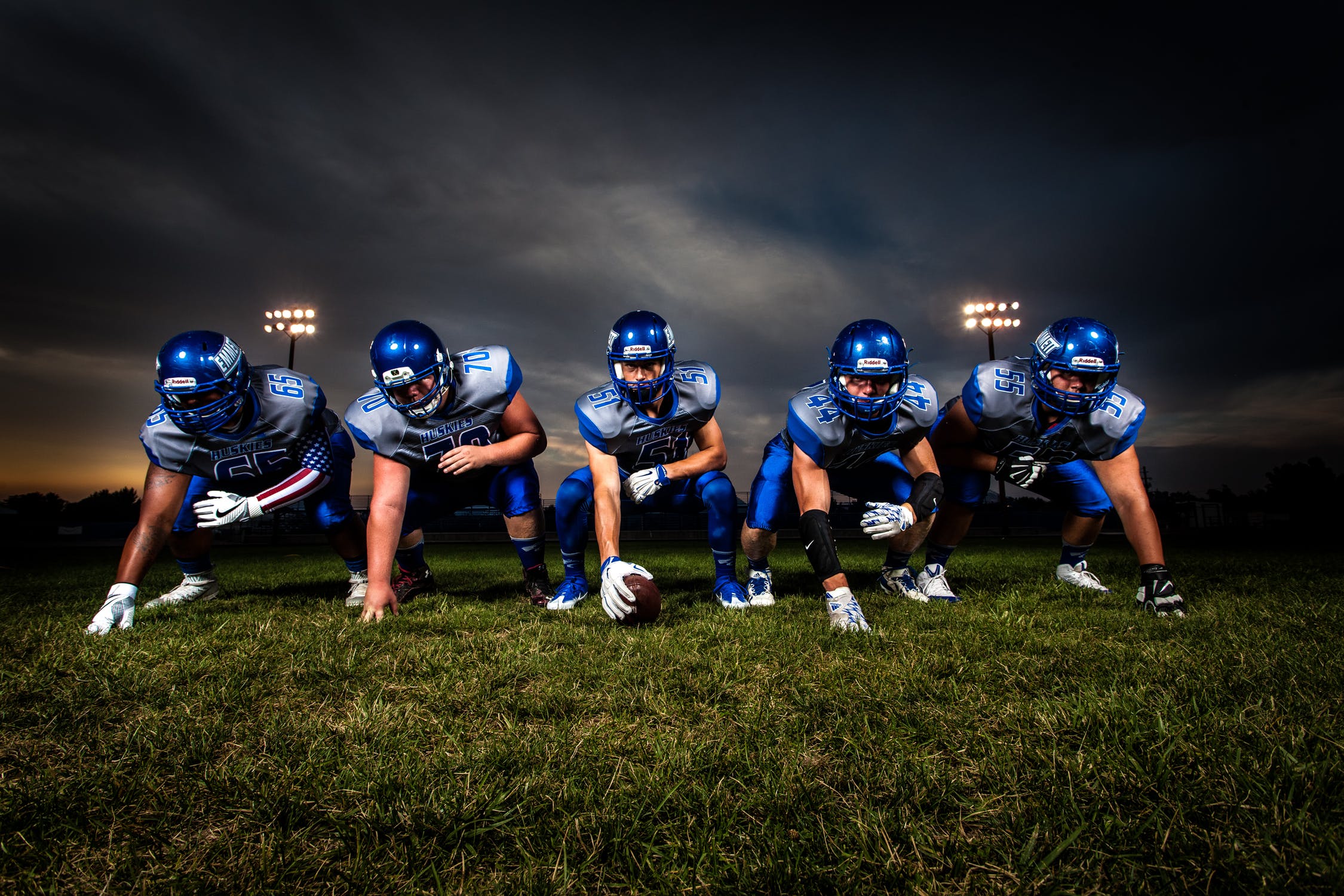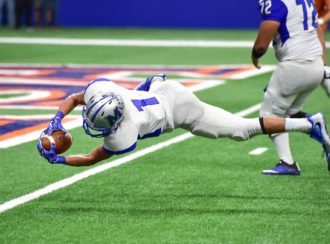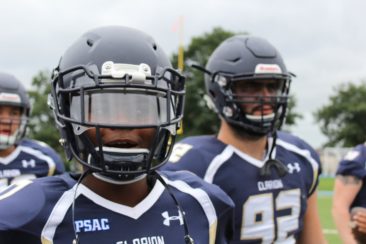Do you want in on the excitement? With eleven players on each side of the field, it can be difficult for a new football fan to grasp the significance of each position, and how they work together. Over time, these positions have become highly specialized and every player knows exactly what to do at specific points in the game. The line of scrimmage divides the 2 teams, one of which is playing offensively, while the other is on defense. Read on to learn the basics about the various positions that make up one of America's favorite things—a football team.

Table of Contents
1. Defense
1.1. Defensive Linemen
1.2. Linebacker
1.3. Defensive Backs
2. Offense
2.1. Quarterback
2.2. Offensive Line
2.3. Running Back
2.4. Tight End
2.5. Wide Receiver
3. Kicking Unit
3.1. Kicker
3.2. Punter
3.3. Gunner
Defense
The defense's objective is simple—keep the offense from scoring a touchdown. This is accomplished primarily by tackling and intercepting the ball. The best defensive players are able to anticipate what the offense wants to do, and stay a step ahead. There are common defensive schemes most teams adhere to, but the eleven defenders can line up anywhere they want. Let's take a look at the key defensive positions.
Defensive Linemen
The first line of defense, defensive linemen are positioned directly across from the ball, which is on the offensive line. They wear jersey numbers 50-79 and 90-99.
- Defensive tackles (DT): There are 2 defensive tackles. Their goal is to stop the opposition from running the ball, often by rushing the quarterback or taking on several blockers at once.
- Defensive end (DE): They're the outer 2 members of the defensive line. Defensive ends are to overcome the offensive linemen and quickly tackle the quarterback or ball carrier, or force them out of bounds.
- Nose tackle (NT): Positioned in the middle, the nose tackle gets hit from all sides; so they're often one of the largest, strongest players on the field.
Linebacker
Linebackers are positioned a couple of yards behind the defensive line. They're often expected to defend the run and the pass, and are generally the team's best tacklers. Their jersey numbers can range from 40-59 and 90-99.
- Inside linebacker (ILB): There can be 2 inside linebackers across from the offensive guards that put a stop to running plays down the middle.
- Middle linebacker (MLB): Typically the leader of the defense, the middle linebacker sits across from the offensive center and should be both an excellent tackler, and very fast.
- Outside linebacker (OLB): Many defensive schemes employ 2 outside linebackers to rush the pass and/or tackle the quarterback. They're generally smaller and faster than inside linebackers.
Defensive Backs
The last line of defense, defensive backs are quick and sturdy enough to tackle players much bigger than them. Their jersey numbers are between 20-49.
- Cornerback (CB): The 2 widest positions, cornerbacks cover wide receivers. Both positions are the fastest players on the field, which makes for exciting match-ups.
- Strong safety (SS): Positioned several yards in the defensive backfield, the strong safety functions like an added linebacker that can challenge larger players.
- Free safety (FS): Typically the deepest defensive player, free safeties want a full view of the field and no one behind them. The free safety calls out the assignments for the other defensive backs before the play.
back to top
Offense
Set, hike! The offense wants to score—whatever it takes! Kicking field goals, moving the ball down the field, and landing touchdowns all require a strong offensive team that's mastered their unique responsibilities. Without further ado, let's get into the key offensive positions.
Quarterback
The quarterback (QB) is the head honcho, positioned behind the center. They call the play in the huddle, the signals at the line of scrimmage, and they receive the ball from the center to throw to the receiver. The ideal quarterback has strong leadership skills, brains, and an especially gifted arm. Their jersey numbers are 1-19.
Offensive Line
Typically the most hulking players on the field, the 5 offensive linemen block for the ball carrier. They're positioned along the line of scrimmage in jersey numbers 50-79.
- Guard (G): 2 guards are positioned on either side of the center and they often run the farthest on running plays.
- Tackle (T): A right (RT) and left tackle (LT) line up outside of the guards where they're often blocking on running plays. A talented offensive tackle can be even more valuable than a quarterback.
- Center (C): this is the player that snaps the ball to the quarterback to start the play and from there they plow forward to block the defensive nose tackle.
Running Back
Running backs' (RB) jerseys are numbers 20-49. They're lined up in backfield, but they aren't required to stay behind the offensive line. There are several different terms associated with running backs, but we'll look at the 2 main types.
- Fullback (FB): With a primary mission to block, fullbacks are usually sizeable, mighty players.
- Halfback (HB): The ideal halfback is agile on their feet because they're the ones running the ball the most throughout the game, and consequently, getting tackled the most.
Tight End
Tight ends (TE) serve as both receivers and blockers. Typically positioned either to the right of the tackle, or to the left of the quarterback, the tight end can act as another wide receiver. They wear jersey numbers 40-49, or 80 and 89.
Wide Receiver
With a speed comparable only to the defensive cornerbacks, wide receivers (WR) try to elude defenders and catch the ball while running downfield. There are 2-4 wide receivers for every play, some splitting wide while others stick closer to backfield. Their jersey numbers are 10-19 and 80-89.
back to top
Kicking Unit
When it comes to field goals, kickoffs, and extra points, a specialized group of players take the field. Let's check out who belongs to the kicking unit.
Kicker
With the ball poised on a tee that holds it upright, the kicker sends it through the field goal (hopefully) or soaring across the field. They're tagged in for all 3 situations mentioned above: field goals, kickoffs, and extra points. There's also a kick returner, often one of the fastest players on the team, who chooses to either run the ball, or down it by taking a knee so the offense can take possession at its own 35 yard line.
Punter
When the offense is short of the line to gain and has reached the fourth down, they can decide to punt the ball, rather than go for a first down. In this case, the punting team heads to the field where the punter receives the snapped ball from the center and kicks it to the punt returner who is waiting downfield.
Gunner
In the case of a kickoff, gunners specialize in running downfield to tackle the kick returner before anyone else gets there. They do have to watch out for one player in particular, though, and that's the jammer, whose sole job is to slow down the gunner.
back to top
Prescription Football Glasses at SportRx
We hope this helped shed some light on the positions of football. Are you a football player who needs prescription football glasses? Done. When you shop with us, you’ll find video guides and tooltips throughout the build process as you customize the perfect pair. An answer to all your questions is at your fingertips, and if you want to chat with an expert, Contact Us. We’ll put you in touch with one of our friendly in-house opticians who can help you build your prescription football glasses.
Ditch risky online shopping with the See Better Guarantee. Try your football glasses for 45 days. If you’re not satisfied, send them back. Get a full refund, exchange, or credit towards a better pair. And return shipping? Covered. Get your pair of prescription football glasses at SportRx today!



